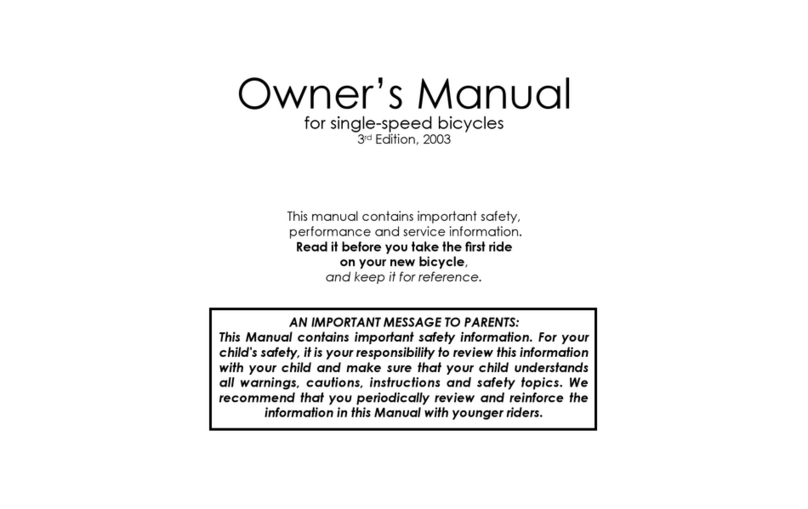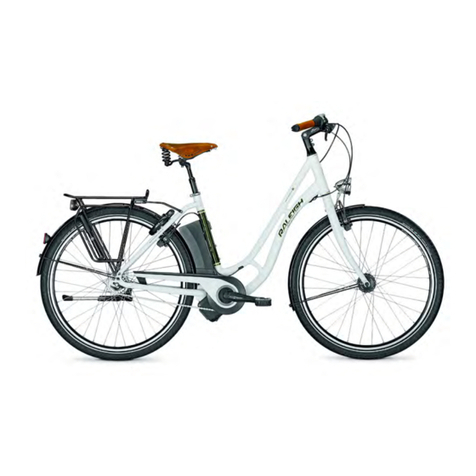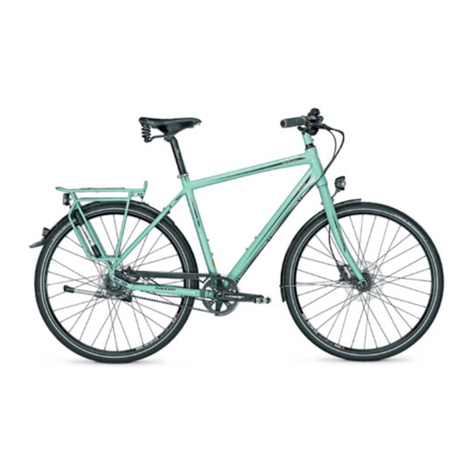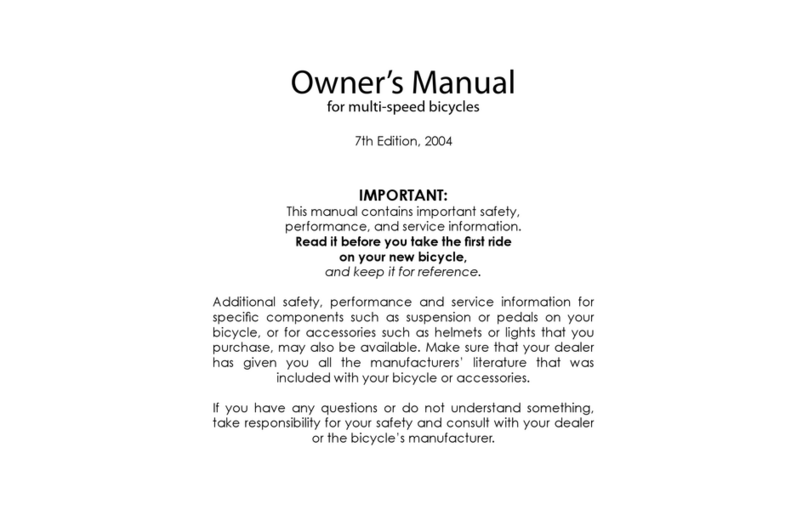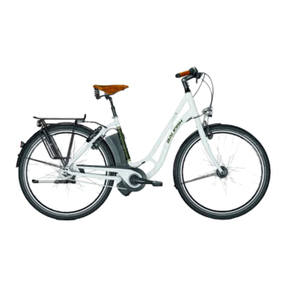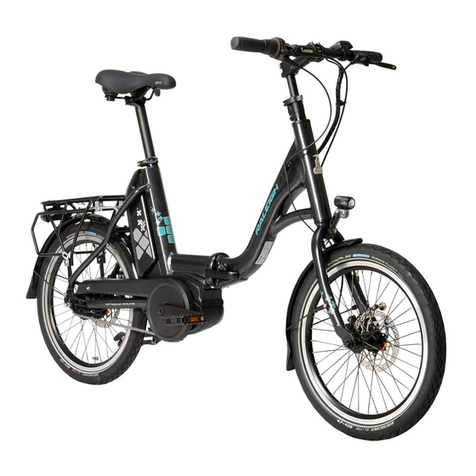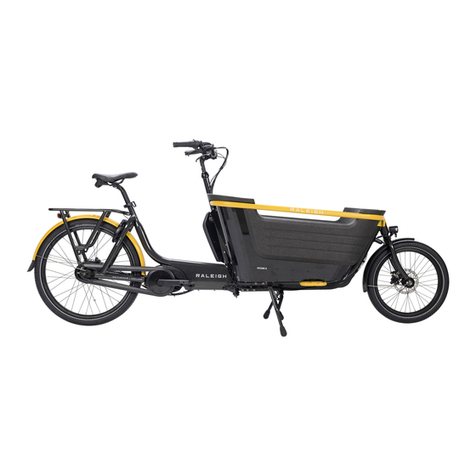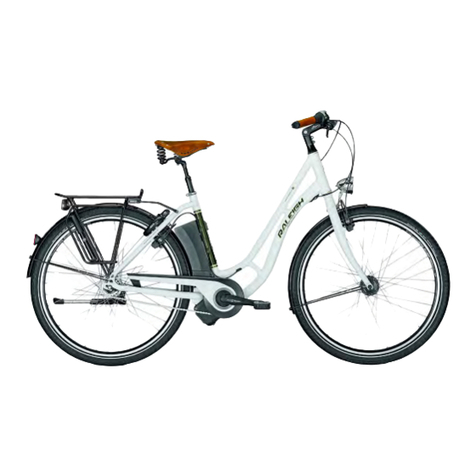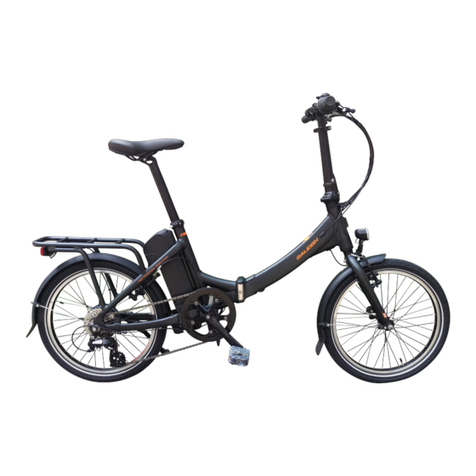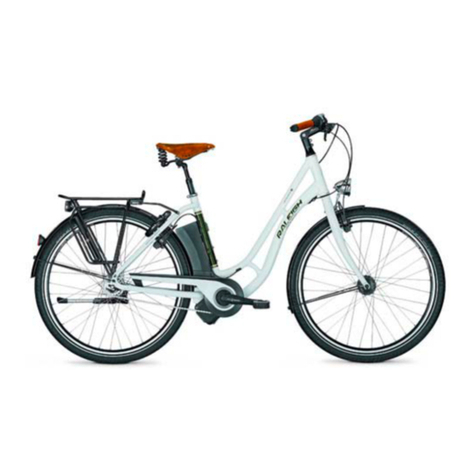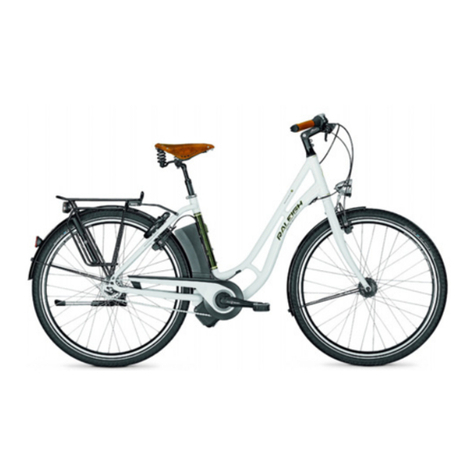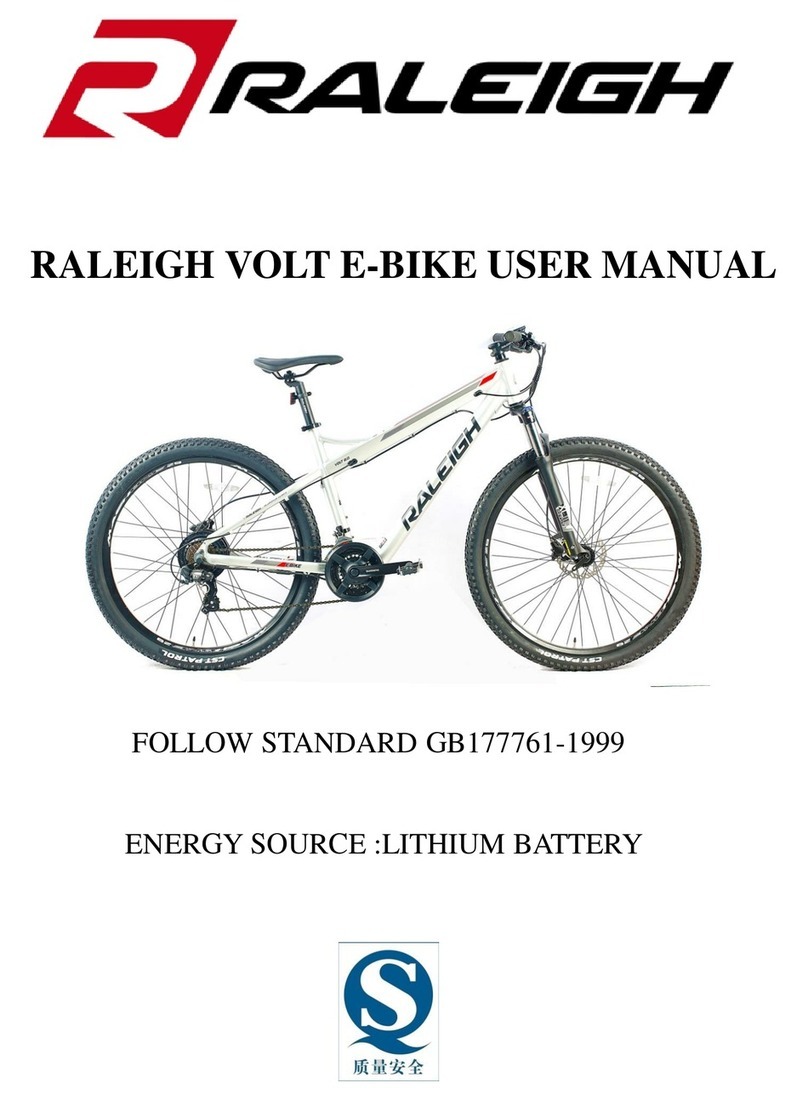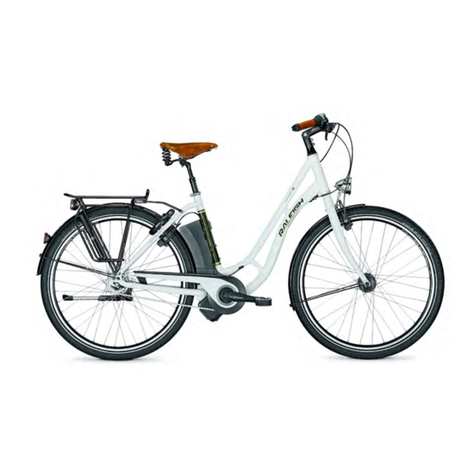Additional tools may be
required, such as a Phillips
screwdriver, spanner and
pliers.
BRAKE LEVER
ADJUSTMENT
This bicycle is fitted with
brake levers which can be
adjusted to suit your child’s
handgrip to give safe and
comfortable operation.
The brake lever reach can
be adjusted by rotating the
screw ‘1’ with a screwdriver.
Ensure that the brake
levers can not rotate on the
handlebar, insert
screwdriver in the hole ‘2’
to tighten.
LUBRICATION
In order that your child’s bicycle remains in top working
condition, it is important to lubricate the parts shown.
This should be done when the bicycle is new and at
regular intervals. We recommend using cycle oil.
IMPORTANT: Do not overlubricate. Wipe clean any
spills or excess. Never lubricate the brake blocks or
rims. Never allow children access to the lubricant.
Lubricate the following items:
• The chain ‘1’ -
lightly along its length
• The freewheel ‘2’ -
apply 2 or 3 drops
• The brake caliper pivots ‘3’
apply 1 drop
TYRES
It may be necessary to inflate the tyres on your child’s
bicycle before it is ready to ride. Recommended tyre
pressures are moulded on the sidewall of the tyre.
WARNING: Do not use a garage airline to inflate the
bicycle tyres, there is a risk of serious injury.
CLEANING
To clean the chrome and enamel parts, use warm
soapy water, rinse with clean water and finish with a
dry duster. Keep the chain free from dirt by regularly
wiping down with a lint free rag. You may find a stiff
paintbrush useful for cleaning between the links.
STORAGE
When not in regular use the bicycle should be stored
upside down to protect the tyres. If storage is to be for
some time, metal parts should be smeared lightly with
grease. Be sure to remove oil or grease from the wheel
rims before the bike is used again.
ADULT SUPERVISION & USER
Before each use of the bicycle:
A. Refer to the assembly instructions
and check wheels, tyres, stabilizer
fitting and brakes. Ensure all bolts are
fully tightened.
B. Examine bicycle for damage and
replace any damaged part immediately
Weekly
Inspect brake cables for signs of fraying
or wear. replace if evident. Replace
annually in any case as a precaution.
Monthly
Check as weekly, plus chain, all nuts,
bolts, screws, clamps and pedals are
secure.
Yearly
We recommend that your child’s bicycle
is fully serviced by an approved Raleigh
Service Dealer at least once a year.
Adult Supervisor and User
Precautions
Ensure the child (user) is appropriately
dressed.
Never use on hills, slopes, roads or
where vehicles or animals may have
access or be present. Never use in
kitchens or in any area adjoining stairs,
steps, kerbs or patio windows.
Only use on obstruction free smooth
level and uniform carpeted, tiled,
tarmac, concrete or lawned surfaces.
Ensure the user can sit on the bicycle
un-aided.
Never allow more than one child to use
the bicycle at one time.
Ensure the user always looks in the
direction the bicycle is travelling and
takes care to avoid other children or
unforeseen obstruction.
Never allow the user to put any part of
the bicycle in his or her mouth or to
attempt to put any part of his or her
body, or any plaything into any moveable
or moving part of the bicycle or between
any part of the bicycle and the tyres,
wheels, mudguards, chainguard, chain
or brake components. Instruct the user
accordingly.
When re-adjusting the handlebars or
seat always observe assembly
instructions.
Always carry out the routine safety
checks and maintenance
Wet conditions impair the braking
efficiency of all bicycles. Take care.
Working Instructions
Observe the precautions above.
Carefully seat the child on the fully
assembled and checked bicycle.
Straighten the child’s legs to check that
soles of both feet touch the ground
whilst the child is seated. Refer to
assembly instructions if saddle requires
adjustment.
Check the child is comfortably
positioned then place the child’s feet
on two pedals.
Stand to one side of the bicycle and
assist the child by gripping the rear of
the saddle with one hand and the
handlebars with the other and gently
move and steer the bicycle forward.
Demonstrate the steering to the child
until he or she has mastered the
function and operation. The stabilisers
protrude at the rear of the bicycle and
the child should be taught to steer
accordingly.
Demonstrate the function and operation
of the brake, and finally the pedals to
drive the bicycle forward.
It will take a little time for the child to
master and then coordinate each
operation. Similarly it may take time
for the child’s muscles to develop
sufficiently to carry out all the
operations. Only when the child has
reached these stages and is able to
balance the bicycle with the aid of
stabilisers should the child be allowed
to use the bicycle unassisted, though
not unsupervised.
PRECAUTIONS
BRAKES
IMPORTANT: IF THE REACH IS
ADJUSTED, IT MAY BE NECESSARY TO
MAKE ADJUSTMENT TO THE CALIPER
- REFER TO THE SECTION ON BRAKES
To provide safe braking, the brakes on
your child’s bicycle should operate with
minimum movement of the lever.
However they should not be adjusted so
closely that the brake blocks touch the
rim without pressure on the lever.
ADJUSTMENT
Minor adjustment of the brakes can be
made using the barrel adjuster. Loosen
the locknut ‘4’, turn the adjuster ‘3’ until
the brakes are set just clear of the rim.
Approx 1.5mm each side. You may find
it easier to turn the adjuster while
holding the brake blocks against the
rim, to reduce the cable tension.
Remember to tighten the locknut ‘4’
after adjustment.
If all the adjustment has been taken up
by the barrel adjuster, it will be
necessary to adjust the cable length.
Screw the barrel adjuster ‘3’ half way
down, tie the brake blocks against
the rim with a piece of string to
reduce the cable tension and undo
the cable pinch bolt ‘5’.
Pull cable through with a pair of
pliers and tighten the pinch bolt
firmly. Fine adjustment can now be
achieved using the barrel adjustment.
If one block is closer to the rim than
the other, adjust by tapping the caliper
spring ‘6’ on the opposite side.
GUARANTEE
Parts bag contains:
1 x Spanner
1 x Allen key
2 x Stabilisers
2 x Pedals
This product must be assembled by an adult.
Not suitable for children under 3 years old.
SUPPLIED WITH YOUR BIKE Parts List
A. Head parts
B. Front wheel nut
C. Rear wheel nut
D. Front fork
E. Head bushing
F. Chain
G. Handlebar
H. Front brake lever
J. Stabilisers
K. Front wheel
L. Front mudguard
M.Rear mudguard
N.Rear wheel
O. Saddle clamp
P. Frame
Q. Chainguard
R. Crank and chainwheel
S. Pedal set
T. Saddle
U. Front brake
W.Brake block
X. Brake cable
Z. Handlebar grips
The bicycle guarantee against manufacturing or materials defects from the date of the original purchase, for the period of one year
provided the bicycle has been properly cared for, maintained and used. The guarantee does not cover normal wear and tear, alteration,
accident, misuse, neglect, improper maintenance or commercial use (e.g. hiring). This guarantee in no way seeks to diminish your
statutory rights as a customer.
Raleigh UK Ltd, Church Street, Eastwood, Nottingham NG16 3HT
21 3
4
3
5
6
1.5mm
MAINTENANCE & CLEANING
If you experience any problems whilst assembling this product please call the helpine 01773 532699
1
2
G
Z
H
O
T
M
N
C
JFSRB
Q
E
K
D
W
U
L
A
X
P
